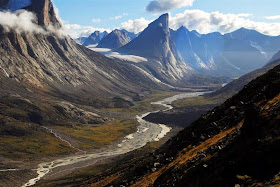How much do we know about Stonehenge? Less than we think. And what has Stonehenge got to do with the Ice Age? More than we might think. This blog is mostly devoted to the problems of where the Stonehenge bluestones came from, and how they got from their source areas to the monument. Now and then I will muse on related Stonehenge topics which have an Ice Age dimension...
Pages
▼
Wednesday, 13 August 2014
Mount Thor, Baffin Island
Mount Thor is a mountain peak that has been effectively chopped in half by glacial erosion. It lies on the flank of the Akshayuk Pass, an extraordinary through valley that runs across the southern part of Baffin Island, coast to coast -- Cumberland Sound to Davis Strait. It's 97 km long, and is reminiscent of the through troughs found in East Greenland. Probably it was cut by ice flowing from the Laurentide Ice Sheet -- and its age is uncertain. It might have been deepened more and more over a sequence of glacial episodes. Certainly the trough, and the peak, have little to do with the local mountain glaciation which is much in evidence today. The more modern glaciers and much smaller than that which cut the trough and cut Mount Thor in half -- one of these glaciers can be seen in a "hanging trough" in some of the photos above. On the overhanging mountain face overlooking the pass, the free rock wall is over 1 km high. The location is shown by the marker "A" on the satellite image below.
From Wikipedia:
Mount Thor, officially gazetted as Thor Peak, is a mountain with an elevation of 1,675 m (5,495 ft) located in Auyuittuq National Park, on Baffin Island, Nunavut, Canada. The mountain is located 46 km (29 mi) northeast of Pangnirtung and features the Earth's greatest vertical drop of 1,250 m (4,101 ft), with the cliff overhanging at an average angle of 15 degrees from vertical.[2] Despite its remoteness, this feature makes the mountain a popular rock climbing site.







Brian,
ReplyDeleteAmazing photos! The U-shaped glacial channels here are so clear and convincing. And the huge size of these can only suggest immense and powerful geological transformations of the planet. Nothing like anything happening now. Amazing what Nature can do! Always worth keeping in mind when thinking of the geological past and the present landscape features.
Kostas
It's still happening, Kostas. Big troughs carrying vast ice streams still exist in Antarctica and in Greenland. As ever, the present is the key to the past......
ReplyDeleteNo Brian. The Past is the key to the Present! Or it should be!
ReplyDeleteKostas